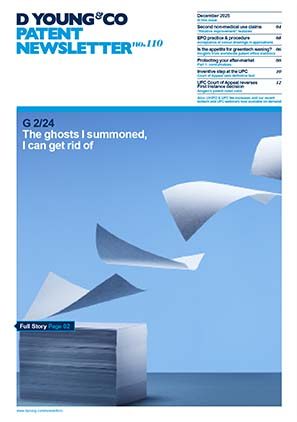UKIPO Manual of Patent Practice: January 2025 Section 1 updates
At the start of January 2025 the United Kingdom Intellectual Property Office (UKIPO) issued an updated version of the Manual of Patent Practice. This is the document which lays out the UKIPO’s approach to patent examination. The most significant of the updates are found in Section 1, which relates to the patentability of inventions; defining which inventions can and cannot be successfully patented.
In particular, this revision of the Manual of Patent Practice sees significant updates to sections relating to the patentability of various computer-related inventions. This is partly in response to the outcome of the Court of Appeal’s decision in the Emotional Perception artificial intelligence (AI) case in July 2024, in which it was ruled that artificial neural networks should be considered computer programs (and therefore subject to the corresponding exclusions to patentability). A further appeal will be heard in the UK Supreme Court, so it may be the case that further revisions to the Manual of Patent Practice are in the near future if the Court of Appeal’s decision is overturned.
What is a computer program?
The definition of a computer program has been updated in the Manual of Patent Practice with reference to the Emotional Perception AI case. A computer is defined as “a machine which processes information”, while a computer program is “a set of instructions for a computer to do something”. So a computer program is any “set of instructions for processing information”. These are rather broad definitions, which can be frustrating for applicants as it means that the corresponding exclusions to patentability can encompass a wide range of inventions.
As a part of the revision to this section of the Manual of Patent Practice, the UKIPO has provided clear guidance and examples of what constitutes a technical contribution (the essential characteristic that is required for a computer-implemented invention to be considered patentable). Cases are cited in respect of the five indicators (the so-called AT&T signposts, from [2009] EWHC 343 (Pat)) for determining whether a computer-implemented invention is patentable, with the relevance of each of these cases being discussed in greater detail than previously.
What about artificial intelligence?
The Manual of Patent Practice considers that because practical implementations of AI inventions typically rely on computers, they should be interpreted as computer-implemented inventions. This is the topic at the heart of the Emotional Perception AI case, in which it was argued that an artificial neural network (ANN) was not a computer program as there are no instructions to be executed by a computer. Instead, learned weights are used to convert an input into an output. However, the Manual of Patent Practice has now been updated to indicate the UKIPO’s position that the learned weights are the computer program, as it is these which instruct a machine executing the ANN on how to convert an input into a particular output.
As such, the patentability of AI inventions are to be judged against the criteria for computer-implemented inventions. The guidance also indicates that AI inventions are considered to be mathematical in nature, offering the UKIPO another avenue for rejection in the event that its position changes on whether AI should be treated as a computer-implemented invention.
Are quantum computers treated differently?
The Manual of Patent Practice now provides more detail about how quantum computing inventions are to be treated; in short, they are to be treated in the same manner as any other computer-implemented invention. This is because although the manner in which the computer executes the instructions is different, a quantum computer is still “a machine which processes information”. It is therefore necessary to identify a technical effect resulting from the execution of a program by a quantum computer in order to obtain a patent in this area. Given the relative novelty of this field, there are few positive examples provided which are able to guide applicants on quantum-specific matters (although the detection and correction of errors is referenced as a relevant technical effect). Instead, three decisions are cited in which it was concluded that no technical contribution was made.
Conclusion
While this update does not represent a significant change in practice at the UKIPO, the updates to the Manual of Patent Practice are welcome as they offer a clearer insight into the examination of computer-implemented inventions. We expect further updates to these topics in the Manual of Patent Practice in due course, in response to the decision of the Supreme Court in respect of the Emotional Perception AI case.
Useful link
UKIPO Manual of Patent Practice: dycip.com/ukipo-patent-practice-manual

